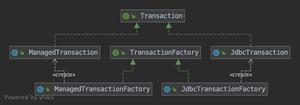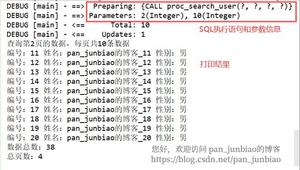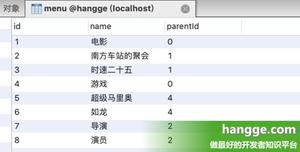MyBatis直接执行SQL的工具SqlMapper
可能有些人也有过类似需求,一般都会选择使用其他的方式如Spring-JDBC等方式解决。
能否通过MyBatis实现这样的功能呢?
为了让通用Mapper更彻底的支持多表操作以及更灵活的操作,在2.2.0版本增加了一个可以直接执行SQL的新类SqlMapper。
我们来了解一下SqlMapper。
SqlMapper提供的方法
SqlMapper提供了以下这些公共方法:
- Map<String,Object> selectOne(String sql)
- Map<String,Object> selectOne(String sql, Object value)
- <T> T selectOne(String sql, Class<T> resultType)
- <T> T selectOne(String sql, Object value, Class<T> resultType)
- List<Map<String,Object>> selectList(String sql)
- List<Map<String,Object>> selectList(String sql, Object value)
- <T> List<T> selectList(String sql, Class<T> resultType)
- <T> List<T> selectList(String sql, Object value, Class<T> resultType)
- int insert(String sql)
- int insert(String sql, Object value)
- int update(String sql)
- int update(String sql, Object value)
- int delete(String sql)
- int delete(String sql, Object value)
一共14个方法,这些方法的命名和参数和SqlSession接口的很像,只是基本上第一个参数都成了sql。
其中Object value为入参,入参形式和SqlSession中的入参一样,带有入参的方法,在使用时sql可以包含#{param}或${param}形式的参数,这些参数需要通过入参来传值。需要的参数过多的时候,参数可以使用Map类型。另外这种情况下的sql还支持下面这种复杂形式:
String sql = "<script>select * from sys_user where 1=1" +
"<if test=\"usertype != null\">usertype = #{usertype}</if></script>";
这种情况用的比较少,不多说。
不带有Object value的所有方法,sql中如果有参数需要手动拼接成一个可以直接执行的sql语句。
在selectXXX方法中,使用Class<T> resultType可以指定返回类型,否则就是Map<String,Object>类型。
实例化SqlMapper
SqlMapper构造参数public SqlMapper(SqlSession sqlSession),需要一个入参SqlSession sqlSession,在一般系统中,可以按照下面的方式获取:
SqlSession sqlSession = (...);//通过某些方法获取sqlSession
//创建sqlMapper
SqlMapper sqlMapper = new SqlMapper(sqlSession);
如果使用的Spring,那么可以按照下面的方式配置<bean>:
<bean id="sqlMapper" class="com.github.abel533.sql.SqlMapper" scope="prototype">
<constructor-arg ref="sqlSession"/>
</bean>
在Service中使用的时候可以直接使用@Autowired注入。
简单例子
在src/test/java目录的com.github.abel533.sql包中包含这些方法的测试。
下面挑几个看看如何使用。
selectList
//查询,返回List<Map>
List<Map<String, Object>> list = sqlMapper.selectList("select * from country where id < 11");
//查询,返回指定的实体类
List<Country> countryList = sqlMapper.selectList("select * from country where id < 11", Country.class);
//查询,带参数
countryList = sqlMapper.selectList("select * from country where id < #{id}", 11, Country.class);
//复杂点的查询,这里参数和上面不同的地方,在于传入了一个对象
Country country = new Country();
country.setId(11);
countryList = sqlMapper.selectList("<script>" +
"select * from country " +
" <where>" +
" <if test=\"id != null\">" +
" id < #{id}" +
" </if>" +
" </where>" +
"</script>", country, Country.class);
selectOne
Map<String, Object> map = sqlMapper.selectOne("select * from country where id = 35");
map = sqlMapper.selectOne("select * from country where id = #{id}", 35);
Country country = sqlMapper.selectOne("select * from country where id = 35", Country.class);
country = sqlMapper.selectOne("select * from country where id = #{id}", 35, Country.class);
insert,update,delete
//insert
int result = sqlMapper.insert("insert into country values(1921,'天朝','TC')");
Country tc = new Country();
tc.setId(1921);
tc.setCountryname("天朝");
tc.setCountrycode("TC");
//注意这里的countrycode和countryname故意写反的
result = sqlMapper.insert("insert into country values(#{id},#{countrycode},#{countryname})"
, tc);
//update
result = sqlMapper.update("update country set countryname = '天朝' where id = 35");
tc = new Country();
tc.setId(35);
tc.setCountryname("天朝");
int result = sqlMapper.update("update country set countryname = #{countryname}" +
" where id in(select id from country where countryname like 'A%')", tc);
//delete
result = sqlMapper.delete("delete from country where id = 35");
result = sqlMapper.delete("delete from country where id = #{id}", 35);
注意
通过上面这些例子应该能对此有个基本的了解,但是如果你使用参数方式,建议阅读下面的文章:
深入了解MyBatis参数
实现原理
最初想要设计这个功能的时候,感觉会很复杂,想的也复杂,需要很多个类,因此当时没有实现。
突发奇想,设计了现在的这种方式。并且有种强烈的感觉就是幸好昨天没有尝试去实现,因为昨天晚上思考这个问题的时候是晚上10点多,而今天晚上7点开始思考。我很庆幸在一个更清醒的状态下去写这段代码。
下面简单说思路和实现方式。
在写MyBatis分页插件的时候熟悉了MappedStatement类。
在写通用Mapper的时候熟悉了xml转SqlNode结构。
如果我根据SQL动态的创建一个MappedStatement,然后使用MappedStatement的id在sqlSession中执行不就可以了吗?
想到这一点,一切就简单了。
看看下面select查询创建MappedStatement的代码:
/**
* 创建一个查询的MS
* @param msId
* @param sqlSource 执行的sqlSource
* @param resultType 返回的结果类型
*/
private void newSelectMappedStatement(String msId, SqlSource sqlSource, final Class<?> resultType) {
MappedStatement ms = new MappedStatement.Builder(
configuration, msId, sqlSource, SqlCommandType.SELECT)
.resultMaps(new ArrayList<ResultMap>() {
{
add(new ResultMap.Builder(configuration,
"defaultResultMap",
resultType,
new ArrayList<ResultMapping>(0)).build());
}
})
.build();
//缓存
configuration.addMappedStatement(ms);
}
代码是不是很简单,这段代码的关键是参数sqlSource,下面是创建SqlSource的方法,分为两种。
一种是一个完整的sql,不需要参数的,可以直接执行的:
StaticSqlSource sqlSource = new StaticSqlSource(configuration, sql);
其中configuration从sqlSession中获取,sql就是用户传入到sql语句,是不是也很简单?
另一种是支持动态sql的,支持参数的SqlSource:
SqlSource sqlSource = languageDriver.createSqlSource(configuration, sql, parameterType);
是不是也很简单?这个方法其实可以兼容上面的StaticSqlSource,这里比上面多了一个parameterType,因为这儿是可以传递参数的,另外languageDriver是从configuration中获取的。
是不是很简单?
我一开始也没想到MyBatis直接执行sql实现起来会这么的容易。
insert,delete,update方法的创建更容易,因为他们的返回值都是int,所以处理起来更简单,有兴趣的可以查看SqlMapper的源码。
总结
以上是 MyBatis直接执行SQL的工具SqlMapper 的全部内容, 来源链接: utcz.com/z/349598.html









